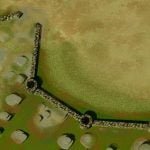
When the Scottish, Ulster Scots and English settlers first arrived in eastern Tennessee and northwestern Georgia, they discovered a continuous chain composed of hundreds of fieldstone structures on the mountain and hill tops between Manchester, TN and Stone Mountain, GA. Some were merely piles of stones that archaeologists call cairns. Others formed small cylinders. Others were small rings. Still others were complex combinations of concentric rings with some perpendicular walls. At least two appeared to be walled villages.
The Cherokees, who had moved into the region during the late 1700s, told the settlers that they didn’t build these structures. Some Cherokees told the Europeans that they had been built by the Creeks. Supposedly, a temple had once stood inside the fortification which contained a giant stone snake with ruby eyes. Other Cherokees told of a legend that these mysterious sites had been built by “Mooneyes,” which the Europeans interpreted as being gray-eyed Europeans. The stories were elaborated to the point that most Whites assumed that the stone cairns and enclosures were built by Celts, specifically a colony of Welsh led by a Prince Madoc.
There are several surviving enigmatic sites in the northern Georgia and western North Carolina that consist of dozens or hundreds of fieldstone cairns. The two largest are located in the Kennesaw Mountain National Battlefield and in Ball Ground, GA near the Etowah River. When in the path of suburban development, some of these cairns have been studied by archaeologists. Artifacts found in the vicinity of the cairns suggest a Late Archaic or Early Woodland construction date (1600 BC – 800 BC.) No human skeletons have been discovered. However, the damp, acidic soil of northern Georgia can completely consume skeletal remains in little over a century.
Some of the fieldstone enclosures, such as the one on Ladd’s Mountain, were clearly for astronomical observations and ceremonies.(See article on the Ladd Mountain Observatory.) Other sites, such as the enclosures on Fort Mountain, GA, at Brown’s Mount, GA and near Manchester, TN were much larger and probably had some military functions. Very little archaeological work has been done at Fort Mountain, but at Old Stone Fort, TN, there is evidence of some structures.,(See article on Old Stone Fort.) These were possibly the houses of priests & retainers, or perhaps temporary shelter for celebrants when the enclosures were used for seasonal ceremonies. Both Fort Mountain & Manchester’s Old Stone Fort had gates oriented to the solar azimuth.

Most archaeologists have assumed that Fort Mountain could not have been a fortification because its rock walls only extend along the western and southern brow of the mountain. Also, at most of the fieldstone structure sites, there is not enough stones visible to have created a wall high enough to stop an enemy. Generally, the volume of stones would create a wall about 18” (.5 m) to 36” (100 m) high. The stone walls at Brown’s Mount and at the Old Stone Fort in Manchester also are discontinuous and by themselves could not have provided adequate protection.
In the summer of 2005, the writer went on a grande tour of the surviving prehistoric fieldstone structures in southeastern Tennessee, northwest Georgia and at Brown’s Mount in middle Georgia. Perhaps a historic preservation architect looks for different evidence than an archaeologist. What immediately was apparent to the author was that there were only stone walls where the soil was very shallow. When the soil depth exceeded about two feet, earth berms took their place. The fieldstone walls and earth berms were not fortifications per se, but rather buttresses to support vertical timber palisades. Few timber palisades have been identified by archaeologists at Woodland and Sedentary village sites in the Southeast. However, the possibility of timber palisades at the mountaintop enclosures suggest that this was a tradition going back much further than the palisades of the “Mississippian” towns (900 AD – 1600 AD).

